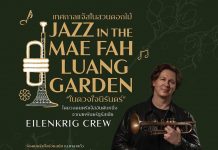Will anyone disagree when we say North Thailand is the region that is richest in culture and tradition?
Probably not as volumes have been written to illustrate the wealth of Lanna heritage in Chiang Mai and Chiang Rai, two provinces that have influenced the life and times of Mekong River basin in their gateway travel role.
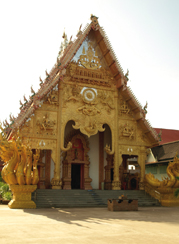
But there is much more to North Thailand that is now catching the eye of discerning travellers. Nan is one province often hidden from the spotlight that deserves to be a hot spot for tourists asking for more than shopping and beaches.
Nan shares its border with Laos in the North and East so it will ultimately become an important gateway for trade and tourism linking Thailand, Laos and China.
Nan shares a 277 km border with Laos. One important checkpoint for international visitors, who want to visit Laos, is Ban Huay Kon in Chaloem Phra Kiat district (138 km from Nan town) which is emerging as the ‘adventure’ gateway to Muang Ngeun in Xaignabouli province, Laos.
From here it is possible to travel to Luang Prabang in Laos using road and ferries.
Apart from offering a gateway to Laos and the shortest route to Luang Prabang, Nan has an abundance of cultural and natural attractions to keep a tourist busy for a couple of days. The province is famous for its attractive temples, many of them located all within a short walk of each other in the town centre.
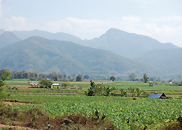
Transport
It takes almost a day to travel the 668 km from Bangkok to Nan that nestles in a valley surrounded by high mountains. On the way, take a stop in Phrae a town famous for its teakwood furniture. If you need to fly then there is just one airline, Nok Air, offering three weekly flights from Bangkok’s domestic Don Meuang Airport. Kan Airlines operates four weekly flight from Chiang Mai to Nan.
Tours and Attractions
• Cultural and traditions
One of the most famous temples is Phumin Temple, located in the compound of the old city in Nai Wiang sub-district, Meuang district.
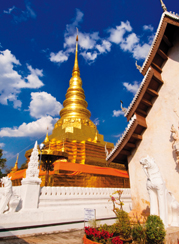
Phumin Temple, which has ‘royal status,’ is renowned for its beautiful mural paintings called Hup Taem, that depict Buddhist Jataka stories (stories that tell about the previous lives of the Buddha) and also other famous paintings like Yu Khuang traditional painting, that show Thai Lue ethnic lifestyle as well as the Pu Man – Ya Man paintings.
Phrathat Chang Kham Worawihan Temple is also in Mueang districtlocated on Suriyaphong Road, opposite the Nan Municipality Office. Previously known as Wat Luang, the temple is famous for the sculptures of the front half of elephants made of brick and cement. The sculptures surround the base of a bell-shape pagoda. Within the Wiharn, is housed the Phra Phuttha Nanthaburi Si Sakkayamuni Buddha image made of 65% pure gold in the posture of forgiveness.
Phrathat Khao Noi Temple in Chai Sathan sub-district, Mueang district houses Buddha relics. The highlight of the temple is its viewpoint of Nan and the surrounding valley. Also the courtyard, there is a 9-metres Buddha image of Phra Phuttha Maha Udom Mongkhon Nanthaburi Si Nan facing the town.
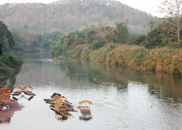
Nan National Museum is a treasure trove of information about the province’s traditions and history. The museum is on Phakong Road, opposite Phrathat Chang Kham Temple and near Phumin Temple, which makes it easier for tourists to combine attractions in one trip. It was constructed as the city hall but later turned into a museum. Open daily 0900 to 1600. Entrance: Bt100. You will need a guide to translate the descriptions that are in Thai.
The signature attraction of Nan is Phrathat Chae Haeng Temple. It houses several Buddha relics as well as silver and golden votive tablets. It is understood that construction of Phrathat Chae Haeng Temple was influenced by the Phrathat Hariphunchai Pagoda in Lamphun province. The temple opens daily from 0600 to 1800.
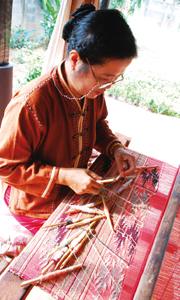
• Community tourism
For those looking for authentic lifestyles particularly ethnic groups, Nan has several spots.
Nong Bua Thai Lue Village is located in Ban Nong Bua, Pa Kha sub-district, Tha Wang Pha district. The Thai Lue or Tai people are valley-dwelling rice cultivators from China’s southwest frontier. This village is renowned for its local fabric weaving called Pha Lai Nam Lai and is the source of most of Nan’s soft handicrafts.
Ban Mani Phruek Security Development Project is an agro-tourism attraction. Located in Thung Chang district, 98 km from Nan town, it is noted for its natural scenery, sightseeing and a Hmong and Kua hill tribe village.
A fisherman lifestyle can also experienced in Nan province at the Pak Nai Fisherman Village in Na Muen district more than 100 km south of Nan town. Originally, it was set on the banks of the Nan River but after the construction of the Sirikit Dam, the village was relocated uphill to the edge of the reservoir. Tourists can rent a boat, or dine at one of the rafts and some villagers offer simple raft accommodation.
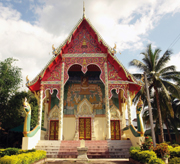
• National parks
Nan has several national parks that are popular for trekking. At Tham Pha Tup Forest Park visitors can enjoy light trekking following a nature study route and visit caves such as Tham Phra and Tham Bo Namthip. The park is located in Pha Sing sub-district, Mueang district.
Si Nan National Park in Na Noi district is also worth a visit. The park is in an evergreen forest high up on a mountain side where visitors will be able to see wild peacocks, and possibly elephants that inhabit the mountain ranges between Thailand and Laos.
• Border tourism and gateway to Laos
Nan shares its border with Laos at Chaloem Phra Kiat district.
The checkpoint is 138 km from Nan town and is open daily from 0800 to 1800. For further information, contact Nan Immigration Office, 054711913 www.nanimmigration.com or Ban Huay Kon – Muang Ngeun checkpoint 054693530. The checkpoint is the gateway to Muang Ngeun and from there it is possible to travel to Luang Prabang.
From Muang Ngeun travellers use a combination of boat and buses. By boat, the distance is 180 km via Pak Bang – Pak Ou and finally to Luang Prabang.
By road, there are three routes:
Huay Kon – Muang Ngeun – Hong Sa – Jom Petch – Luang Prabang Route. This route is popular during the dry season as the distance is just 152 km.
Huay Kon – Muang Ngeun – Hong Sa – Xaiyabouly – Tha Dua – Luang Prabang Route. Can be travelled year-round, but the distance is longer at 250 km.
Huay Kon – Muang Ngeun – Pak Bang – Udomxai – Luang Prabang Route. The most comfortable route on a paved road, but it is also the longest route at 350 km.




